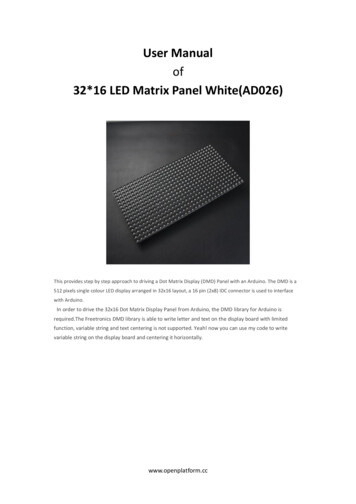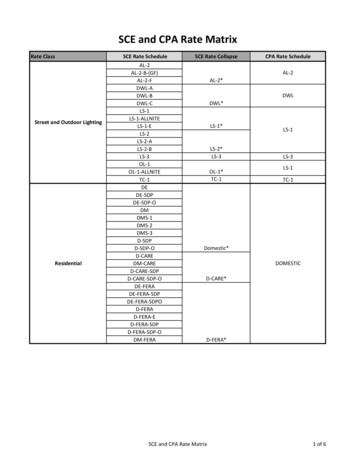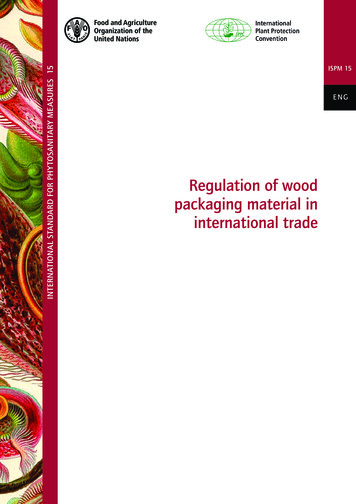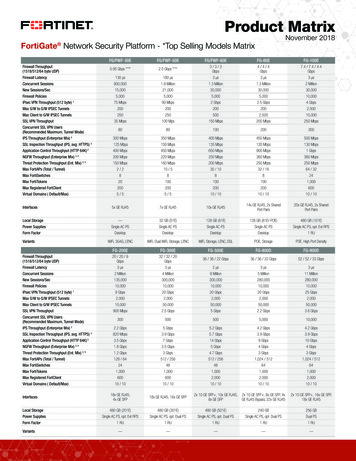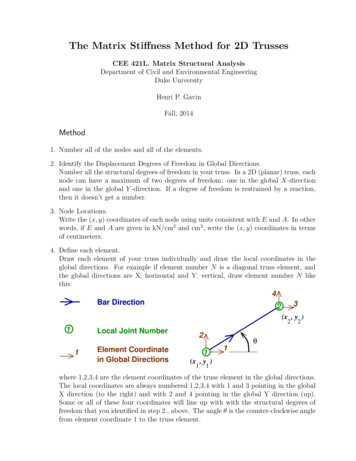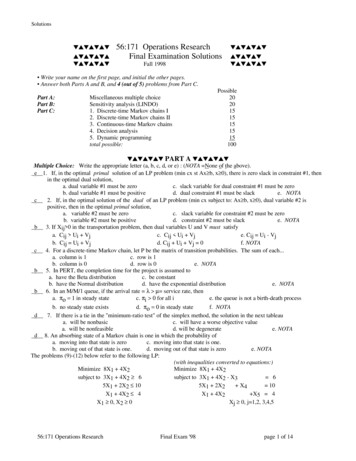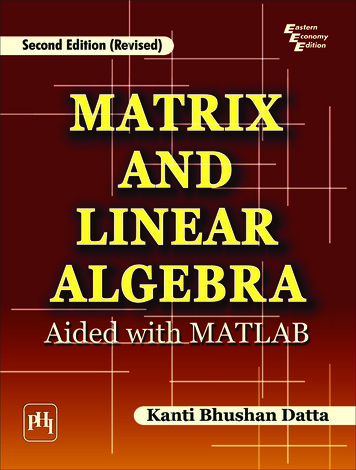
Transcription
Second Edition (Revised)MATRIXANDLINEARALGEBR AAided with MATLABKanti Bhushan Datta
Matrix and Linear AlgebraAided with MATLABSecond EditionKANTI BHUSHAN DATTAFormer ProfessorDepartment of Electrical EngineeringIndian Institute of Technology KharagpurNew Delhi-1100012011
MATRIX AND LINEAR ALGEBRA—Aided with MATLAB, 2nd ed.Kanti Bhushan Datta 2009 by PHI Learning Private Limited, New Delhi. All rights reserved. No part of this bookmay be reproduced in any form, by mimeograph or any other means, without permission inwriting from the publisher.ISBN-978-81-203-3618-6The export rights of this book are vested solely with the publisher.Tenth Printing (Second Edition).February, 2011Published by Asoke K. Ghosh, PHI Learning Private Limited, M-97, Connaught Circus,New Delhi-110001 and Printed by Rajkamal Electric Press, Plot No. 2, Phase IV, HSIDC,Kundli-131028, Sonepat, Haryana.
To my daughterSomantikato provide inspiration for strengthening herskill in mathematics
ContentsPrefacePreface to the First Edition1xixiiiMatrix Algebra1–261.11.2Definition of a Matrix6Operations on Matrices71.2.1Properties of Matrix Addition and Scalar Multiplication1.2.2Properties of Matrix Multiplication101.2.3Properties of Matrix Transposition121.3Symmetric, Hermitian and Triangular Matrices131.4Powers and Trace of a Square Matrix151.5Differentiation and Integration of a Matrix161.6Field and Matrix Over an Arbitrary Field171.7Matrix Operations with ion and Inversion272.2Determinant, Cofactor and Minor2.3Properties of Determinants332.4Evaluation of Determinants37Problems47v28
vi3ContentsInverse of a Matrix3.1Singular Matrix: Adjoint and Inverse of a Matrix3.2Important Properties of Matrix Inversion583.3Inverse of a Matrix by Partitioning59Problems67455–7355Rank and Equivalence4.1Submatrix: Rank744.2Elementary Transformations754.3Equivalence and Normal Form794.4Inverse by Step-by-Step Reduction of [A; I]824.5Inverse from Elementary Matrices824.6Row-Equivalent and Column-Equivalent Canonical Form4.7Properties of Rank864.8Right Inverse and Left Inverse of a Matrix87Problems90574–9284Vector Space93–1625.1Vector Space935.2Linear Dependence, Basis and Dimension975.3 Vector Subspace1045.3.1Vector Space as a Direct Sum of Subspaces1065.4Inner Product Spaces1085.5Orthonormal Basis and Gram-Schmidt Process of Orthogonalization1165.6Linear Simultaneous Equations: Cramer Rule1235.7Rank and Nullity: Sylvester Inequality1345.8Computation of Linear Dependence and Independence of Vectors1395.8.1Gaussian Elimination Method1455.8.2RC (or RREF) Method (Based on Row-equivalentCanonical Form)1485.9MATLAB Methods in Vector Spaces153Problems1576Linear Transformation and Matrices6.16.26.3Linear Transformation163Properties of Linear Transformations169Matrix of a Linear Transformation1806.3.1Matrix of an Identity and a Zero Transformation1846.3.2Matrix of the Sum of Two Linear Transformations and aScalar Multiple of a Linear Transformation1866.3.3Matrix of a Composite Transformation1866.3.4Matrix of an Inverse Transformation187163–225
Contentsvii6.46.56.6Change of Basis188Orthogonal and Unitary Transformations194Linear Functionals: Dual Space: Bidual Space1986.6.1Linear Transformation and Transpose of a Matrix:Dual Space2026.6.2Bidual Space2066.6.3Adjoint of a Linear Transformation208Problems2167Eigenvalues, Eigenvectors and the CharacteristicEquation226–3077.1Eigenvalues, Eigenvectors and the Characteristic Equation of aMatrix2267.1.1Eigenvalues and Eigenvectors of a Linear Transformation2317.2Properties of Eigenvectors Associated with Distinct Eigenvalues2337.2.1Left Eigenvector and Right Eigenvector2377.2.2Diagonalizable Linear Transformation2407.3Matrix Polynomial and Lambda Matrix2417.3.1Matrix Polynomials2417.3.2Lambda Matrix or Polynomial Matrix2427.3.3Composition of Lambda Matrices2437.3.4Operator Polynomial2517.4Characteristic Polynomial, Annihilating Polynomial and MinimumPolynomial2527.4.1Cayley-Hamilton Theorem and Minimum Polynomial for aLinear Transformation2597.5Computation of Characteristic Polynomial and Adjoint of (lI – A)2607.5.1Eigenvalues and Eigenvectors of Matrix Polynomials2657.5.2Newton Formulae, Leverrier Method, and Faddeev Algorithm2677.6Multiplicities of Eigenvalues2717.7Eigenvalue Problem for Hermitian Matrices2747.8Congruent Matrices2917.9MATLAB Aids296Problems2978Bilinear, Quadratic and Hermitian Forms8.18.28.38.48.5Bilinear Forms308Quadratic Forms311Reduction of Quadratic Forms3148.3.1Orthogonal Transformation3148.3.2Lagrange Reduction315Sylvester Law of Inertia323Hermitian Forms326308–363
viiiContents8.6Positive Definite Quadratic and Hermitian Forms: Positive DefiniteMatrices3318.7 Generalized Eigenvalue Problem3408.8 Bases for Matrix Representation of a Bilinear Function346Problems3579Vector Norms and Matrix Norms364–4029.19.2Vector Norms364Matrix Norms3699.2.1 Compatible Matrix Norms3729.2.2 Continuity of Matrix and Vector Norms3739.3 Induced Matrix Norms3749.3.1 Singularity Index3809.4 Equivalent Norms3819.5 Matrix Sequence and Matrix Series3839.6 Generalized Inverse of a Matrix3889.6.1 Least Squares Solution of Ax b3959.7 Solution of Ax b with MATLAB396Problems39810 Normal Forms403–45110.110.210.310.410.510.6Elementary Operations on l-Matrices403Left Equivalence: Column Hermite Forms406Right Equivalence: Row Hermite Forms413Equivalence of Lambda Matrices415Invariant Polynomials and Smith Canonical Forms421Similarity and Equivalence—First and Second Natural Normal Forms:Jordan Canonical Forms424Problems44611 Linear Transformations and Normal Forms11.1 Direct Sum of Subspaces45211.2 Invariant Subspaces46011.3 Root Subspaces: Quasi-Diagonal Form46311.4 Decomposition of Root-Subspaces: Jordan Normal Form11.5 Jordan Forms with MATLAB502Problems503452–50747012 Function of a Matrix12.112.212.3Definition and Evaluation of the Function of a Matrix509Spectral Resolution f (A) when A is Arbitrary51612.2.1 Computation of f (A) Using Vandermonde Matrix521Square Root of a Matrix A, sin A, cos A, In A525508–554
Contents12.4 An Elementary Proof of Jordan Normal Form53012.5 Integral Representation of f (A)53412.6 Further Discussion on Matrix Sequence and Matrix Series12.7 Solution of Vector-Matrix Differential Equations54312.8 Solution of Vector-Matrix Difference Equations54912.9 MATLAB Computation of Matrix Function551Problems551ix53813 Numerical Linear Algebra555–60613.113.2Basic Concepts of Finite Arithmetic555Conditioning and Numerical Stability55713.2.1 Inverse of a Perturbed Matrix: Condition Number55713.2.2 Perturbed Linear Equations: Condition Number55913.2.3 Eigenvalues and Eigenvectors of a Square Matrix56013.3 Orthogonal Transformations56413.3.1 Householder Transformation56413.3.2 Plane Rotation57113.3.3 Least Squares Solution of Ax b57513.4 Numerical Evaluation of Eigenvalues and Eigenvectors57613.4.1 Gerschgorin Method57613.4.2 The Power Method57813.4.3 Method of Deflation58013.4.4 Inverse Iteration58113.4.5 Jacobi and Givens Method58313.4.6 LR-factorization and LR-algorithm58613.4.7 QR-algorithm58913.4.8 Implicitly Shifted QR-algorithm59413.4.9 Double-shifted QR-algorithm59713.5 Determination of Eigenvectors Via Qr-algorithm59913.6 Computation with MATLAB600Problems603References607–612List of Corollaries, Definitions, Examples,Lemmas, Remarks, Theorems613–616Answers617–638Index639–651
PrefaceThis book survived a seventeen-year acid test of the students, professors and other professionals,for which the author is very much grateful. A revision is thought necessary, being propelled bythe motivation of introducing MATLAB for the study of numerical aspect of matrix theory. Thismay urge the students to solve the different chapter-end problems with a computer, withoutmuch computational chore with three p’s (pen-paper-pencil). The semester-oriented engineeringand science educational curriculum keeps on rolling with such great strides that the averagestudents need ready-to-help books to learn the technicalities of solving problems of diversenature to tide over the difficult time of an examination. Worked-out examples are, therefore,provided in great abundance, besides a few diagrams illlustrating the concepts. A large numberof chapter-end problems are incorporated, and answers to all the problems are provided to helpthe student in self-study. So, the learning of matrix and linear algebra, aided with MATLAB,may turn out to be a pleasant trip to a wonderland with twin lovers.As, course material, this book can be used in many ways. For an elementary course, onecan choose Chapters 1–3, Sections 4.1–4.4; 5.1–5.3, 5.6; 7.1, 7.2, 7.4–7.6, skipping the relatedlinear transformation portions. Last but not least, Chapter 13, the most important part from theapplication point of view, outlines numerical linear algebra. These topics may form a forty-hourlecture course of one semester supported by homework and tutorials. The remaining chaptersand sections may form a second semester advanced course on matrix and linear algebra forthose students who are pursuing M.Sc. in Mathematics or Ph.D. programmes.The present book is a revised edition of the book MATRIX AND LINEAR ALGEBRA andis renamed as MATRIX AND LINEAR ALGEBRA: AIDED WITH MATLAB. A SolutionsManual for all the chapter-end problems is now available for the instructors.The introduction of MATLAB and how to use it for matrix computation are the major andsignificant additions to the first edition. Moreover, new sections on square-root of a matrix asxi
Matrix And Linear Algebra : Aided WithMatlab25%OFFPublisher : PHI LearningISBN : 9788120336186Author : DATTA, KANTIBHUSHANType the URL : http://www.kopykitab.com/product/7362Get this eBook
application point of view, outlines numerical linear algebra. These topics may form a forty-hour lecture course of one semester supported by homework and tutorials. The remaining chapters and sections may form a second semester advanced course on matrix and linear algebra
